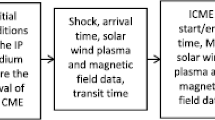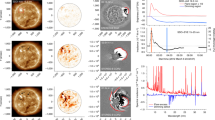Abstract
Arising from F. Miyake, K. Nagaya, K. Masuda & T. Nakamura Nature 486, 240–242 (2012)10.1038/nature11123
Atmospheric 14C production is a potential window into the energy of solar proton and other cosmic ray events. It was previously concluded that 14C results from ad 774–775 would require solar events that were orders of magnitude greater than known past events1. We find that the coronal mass ejection energy based on 14C production is much smaller than claimed in ref. 1, but still substantially larger than the maximum historical Carrington Event of 18592,3,4. Such an event would cause great damage to modern technology5,6, and in view of recent confirmation of superflares on solar-type stars7,8, this issue merits attention.

Similar content being viewed by others
References
Miyake, F., Nagaya, K., Masuda, K. & Nakamura, T. A signature of cosmic-ray increase in AD 774–775 from tree rings in Japan. Nature 486, 240–242 (2012)
Melott, A. L. & Thomas, B. C. Astrophysical ionizing radiation and the Earth: a brief review and census of intermittent intense sources. Astrobiology 11, 343–361 (2011)
Clauer, C. R., Siscoe, G., eds. The great historical geomagnetic storm of 1859: a modern look. Adv. Space Res. 38, 115–388 (2006)
Thomas, B. C., Jackman, C. H. & Melott, A. L. Modeling atmospheric effects of the September 1859 solar flare. Geophys. Res. Lett. 34 L06810, http://dx.doi.org/abs/10.1029/2006GL029174 (2007)
National Research Council Space Studies Board. Severe Space Weather Events — Understanding Societal and Economic Impacts (National Academies Press, 2008); available at http://www.nap.edu/openbook.php?record_id = 12507&page = R1
Hapgood, M. Astrophysics: prepare for the coming space weather storm. Nature 484, 311–313 (2012)
Schaefer, B. E., King, J. R. & Deliyannis, C. P. Superflares on ordinary solar-type stars. Astrophys. J. 529, 1026–1030 (2000)
Maehara, H. et al. Superflares on solar-type stars. Nature 485, 478–481 (2012)
Reedy, R. C. in Solar Drivers of Interplanetary and Terrestrial Disturbances: Proceedings of the 16th International Workshop (eds Balasubramaniam, K. S., Keil, S. L. & Smartt, R. N. ) 429–436 (ASP Conf. Ser. Vol. CS-94, Astronomical Society of the Pacific, 1996)
Schrijver, C. J. Eruptions from solar ephemeral regions as an extension of the size distribution of coronal mass ejections. Astrophys. J. 710, 1480–1485 (2010)
Love, J. J. Credible occurrence probabilities for extreme geophysical events: earthquakes, volcanic eruptions, magnetic storms. Geophys. Res. Lett.. 39, L10301, http://dx.doi.org/10.1029/2012GL051431 (2012)
Ejzak, L. M., Melott, A. L., Medvedev, M. V. & Thomas, B. C. Terrestrial consequences of spectral and temporal variability in ionizing photon events. Astrophys. J. 654, 373–384 (2007)
Calisto, M., Verronen, P. T., Rozanov, E. & Peter, T. Influence of a Carrington-like event on the atmospheric chemistry, temperature and dynamics. Atmos. Chem. Phys. 12, 8679–8686 (2012)
Schrijver, C. J. et al. Estimating the frequency of extremely energetic solar events, based on solar, stellar, lunar, and terrestrial records. J. Geophys. Res.. 117, A08103, http://dx.doi.org/10.1029/2012JA017706 (2012)
Author information
Authors and Affiliations
Contributions
A.L.M. planned and wrote the paper with the assistance of B.C.T. B.C.T. performed the atmospheric computations and made the plot.
Corresponding author
Ethics declarations
Competing interests
Declared none.
PowerPoint slides
Rights and permissions
About this article
Cite this article
Melott, A., Thomas, B. Causes of an ad 774–775 14C increase. Nature 491, E1–E2 (2012). https://doi.org/10.1038/nature11695
Received:
Accepted:
Published:
Issue Date:
DOI: https://doi.org/10.1038/nature11695
- Springer Nature Limited
This article is cited by
-
A history of solar activity over millennia
Living Reviews in Solar Physics (2023)
-
Four New Horsemen of an Apocalypse? Solar Flares, Super-volcanoes, Pandemics, and Artificial Intelligence
Economics of Disasters and Climate Change (2022)
-
Solar Energetic-Particle Ground-Level Enhancements and the Solar Cycle
Solar Physics (2022)
-
Extreme solar events
Living Reviews in Solar Physics (2022)
-
A rapid cosmic-ray increase in BC 3372–3371 from ancient buried tree rings in China
Nature Communications (2017)





